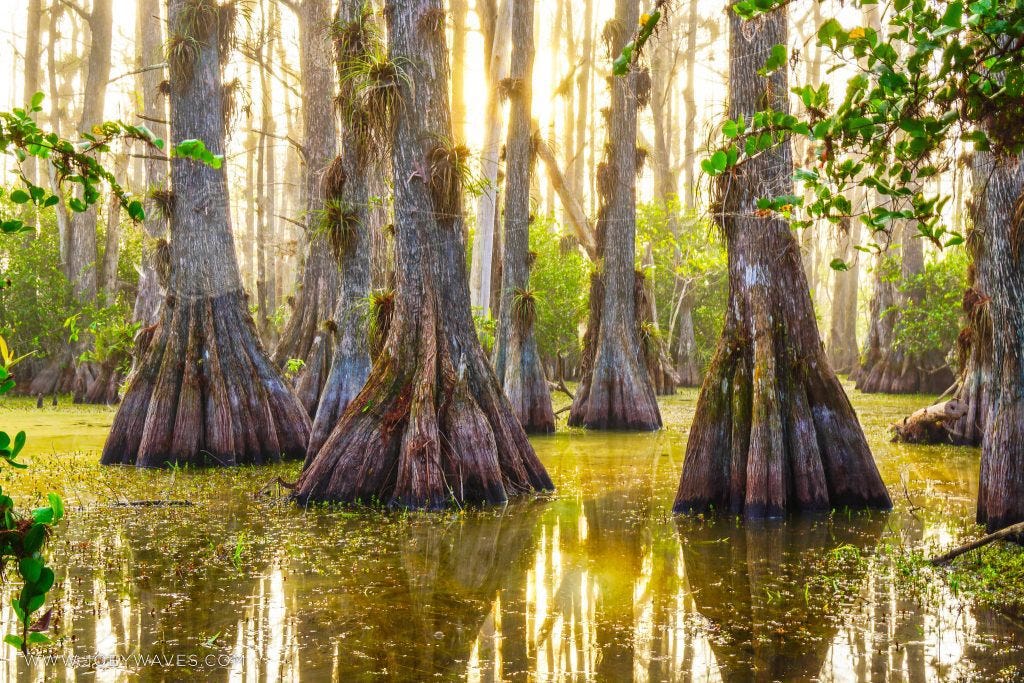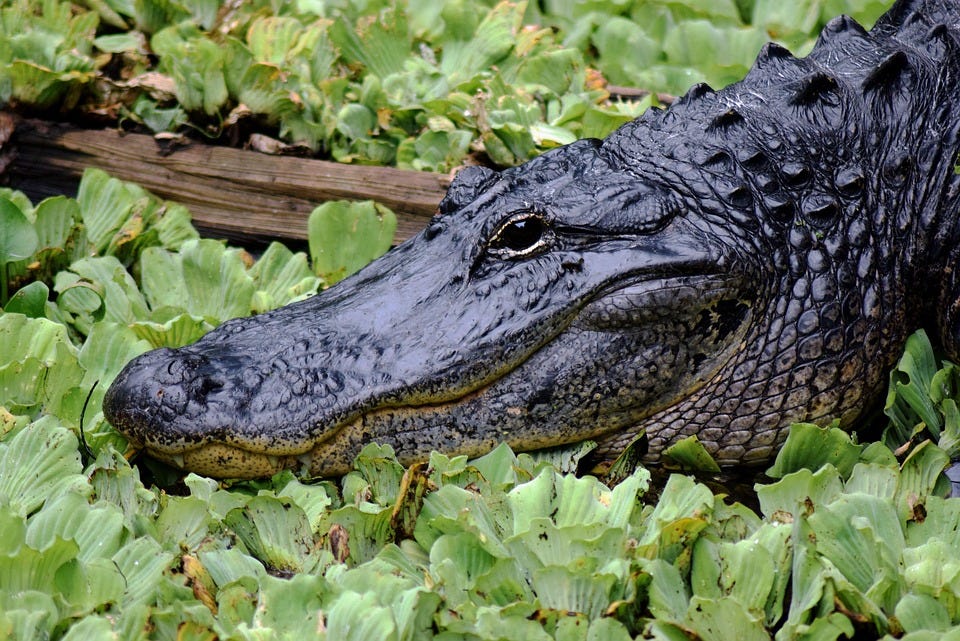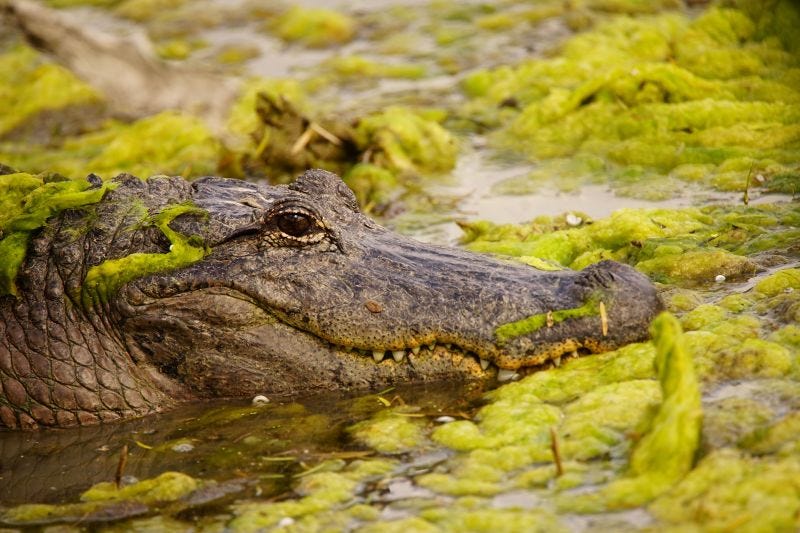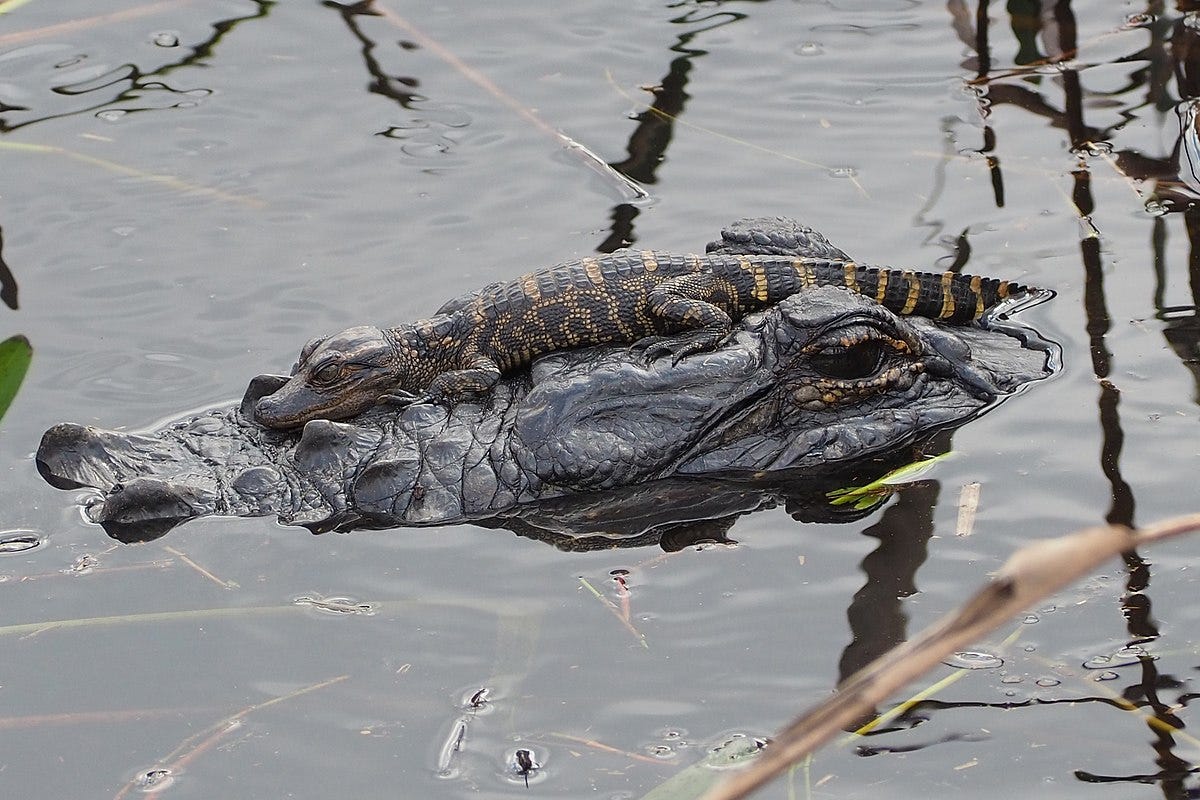Escape from "Alligator Alcatraz"
Among my concerns about the new migrant detention center: the persistent fiction that large reptiles are mindless killers.
Note: This week, a break from memoir and a foray into current events. Thank you for engaging in this conversation! - AM
Deep inside Big Cypress National Preserve, among the freshwater prairies, mangrove forests, and hidden haunts of the few existing Florida panthers, there is federal immigration jail.
“Alligator Alcatraz,” as it is officially named, was thrown together at the end of June 2025, when Governor DeSantis proposed that the public land he’d seized in 2023 could take in migrants detained by ICE, and alleviate pressure on other immigrant jails. The new facility is meant to house 5,000 undocumented migrants, who may have just exited their immigration court hearings, been taken from their homes in the middle of the night, or abducted off the street in broad daylight.
The facility will house immigrants in tents until they can be deported back to their home country (or another one willing to take them with a large check from the Department of Homeland Security.) Meanwhile, extreme heat and hurricanes will be putting the migrants’ lives at risk almost every day.
The Seminole and Miccosukee have voiced concerns about the center’s proximity to their villages and sacred sites, and countless environmental groups have noted that no impact study was conducted on this site plan, and the harm to the region’s biodiversity may go, ironically, undocumented.
Now, as John Mulaney would say, we don’t have time to unpack all of that.
Instead, I want to take a moment to add another, different objection to the voices already decrying “Alligator Alcatraz”: we must stop pretending that large, toothy reptiles are mindless murdering machines.
From Florida Attorney General James Uthemeier stating he wouldn’t “need to invest that much in the perimeter” of the detention center, to news media referring to the abundance of native reptiles as an “infestation,” to Lauren Loomer’s abhorrent X post (not linked as to not to give her views), few people seem to question the idea that the Everglades’ population of American alligators will act as a turret-lined prison wall.
Has it really occurred to no one that these are animals with cognition, emotion, motivation, and priorities that are not unlike, though sometimes at odds with, our own? Do we really mean to imply that alligators will be as effective as armed guards, and that their habitat is less survivable than a concentration camp?
How can the majority of people understand the desperate need to conserve fragile ecosystems, if we still believe the wildlife inside them is solely there to cause harm?
We have to do better.
So, let’s get familiar with the two reptile species that are most talked about in reference to “Alligator Alcatraz.” The first, not an alligator at all, is the Burmese python (Python bivittatus).
Native to southeast Asia, Burmese pythons were introduced to Florida’s ecosystems several times as a result of the pet trade. It is in fact no longer legal to keep a Burmese python as a pet in Florida for this reason. Pythons thrive in the warm, humid climate of the Everglades to a fault. These animals are enormously destructive to the native mammal and bird biodiversity in Florida, and many biologists, as well as ordinary citizens, are employed to find and remove them.
A 10-year study compiling reports of bites from Burmese pythons in Everglades National Park collected five reports, all from field biologists. Two of the incidents resulted in minor puncture wounds, and the other saw no harm (pythons are non-venomous). A 30-year study of all attacks by any large, constricting snakes in the United States found 16 fatalities, all of which were from captive-living animals, the victims being the snakes’ own keepers or young children in the home. (Needless to say, I do not advise keeping Burmese pythons as pets).
Most snakes are mesopredators, meaning that although they eat other animals, still other animals eat them. The issue with Burmese pythons in the Everglades is that they are apex predators as adults, and face few challenges from Florida’s wildlife to their population expansion. Pythons in general are ambush predators, finding a secure place to wait for prey to wander by, and assess using their heat-detection and sense of smell which animal could be a good meal, and what animals they are safer ignoring.
Do Burmese pythons pose a risk to migrants escaping prison? Hardly.
But what about alligators?
The American alligator (Alligator mississippiensis) is an astoundingly large animal. An adult male might achieve 14 feet in length, and weigh more than 1000 pounds. Once hunted to the point of endangered species status, their population recovered enough to be delisted in 1987, such that their status today according to the International Union for the Conservation of Nature is Least Concern. American alligators have a much larger distribution than the other two crocodilian species found in Florida (the Spectacled Caiman (Caiman crocodilus), also an introduced species, and American crocodile (Crocodylus acutus), which has threatened status on the US Endangered Species Act). This is due to the alligators’ greater tolerance for colder temperatures, as they are able to survive for short periods of time in water as cold as 45 degrees Fahrenheit.
Encounters with American alligators are unfortunately not uncommon for average Floridians. The Florida Fish and Wildlife Conservation Commission estimates there are around 1.3 million American alligators in the state, or about one alligator for every 18 people. Due to human habitat expansion, American alligators are now classified as urban wildlife, and around eight alligator attacks on humans are documented per year. Though less than 10% of these attacks are fatal, there is no ignoring the fact that these are incredibly powerful animals. Just in May of this year, a woman was tragically killed by an American alligator who pulled her from her kayak.
But the idea that alligators would routinely feed on humans given the slightest opportunity is immensely unfounded. By contrast, the more we learn about the behavior of these animals, the more we understand their true intelligence, social nature, and strange secrets.
A 2013 study showed American alligators using tools, particularly sticks and twigs, to lure in nesting birds as prey, seeming to understand both the value of the object to their prey, and the seasonality of the prey’s behavior. Alligators have also been observed cooperatively hunting schools of fish, not unlike dolphins, by cornering the fish and taking turns snacking on them. Speaking of snacks, it turns out that alligators sometimes eat fruit, and therefore participate in the seed dispersal of native plants like wild grapes and elderberries.
The most well-known alligator behaviors involve their vocalizations, which are varied and complex, surprising given the limited ability of their vocal chords. These and social displays play a key role in avoiding physical aggressive contact between alligators as they compete for mates and territory. Males display with bellowing and “sprinkling”, a sort of water dance, to attract a female.
The female, once mated, builds a mound of soil and decaying vegetation in which to lay her eggs. She carefully guards them and checks their temperature throughout the incubation process, then protects her young for up to a year after they hatch. This gives the hatchlings a much-needed leg up in life, as young alligators can fall prey to many, many animals. If they survive until they reach about 6 feet in length, American alligators typically live more than 50 years.
Importantly, American alligators are a keystone species, or a species that is critical to the overall structure and function of an ecosystem. Alligators are known for creating “gator holes,” which are depressions dug into the mud with their tail and mouth. These holes stay water-filled through periods of drought. The alligators themselves use these to stay cool, but they also provide shelter and safety for a variety of other animals, including fish, amphibians, and insects, and can host plants that would not survive drying out. American alligators have also come to play a vital role in controlling the population of nutria, another destructive invasive species of the Everglades. Because of this, alligators are actually helping to protect the diversity and abundance of native wetland vegetation from this voracious herbivore.

I’m not at all saying that American alligators are harmless. To the contrary, they are powerful apex predators that should have well earned our respect by now. But humans are not great at respecting the animals we fear; just look at the rattlesnake round-ups, the controversy over wolves in the west, and the horrible things we have done to toothed whales.
So much harm can come to creatures we fear. Respect, not terror, leads to coexistence.
I hope that among the outrage pouring towards this administration’s handling of immigration comes an accompanying feeling of disappointment. Disappointment in the way we’ve painted portraits of thoughtless violence onto these animals, who are trying to live under the pressure of our ceaseless encroachment. “Alligator Alcatraz” is not a solution to America’s vast set of issues with immigration; it is a place actively harming people, wildlife, and the relationship between the two.










Wonderful
Beautifully written - important information. Thank you.